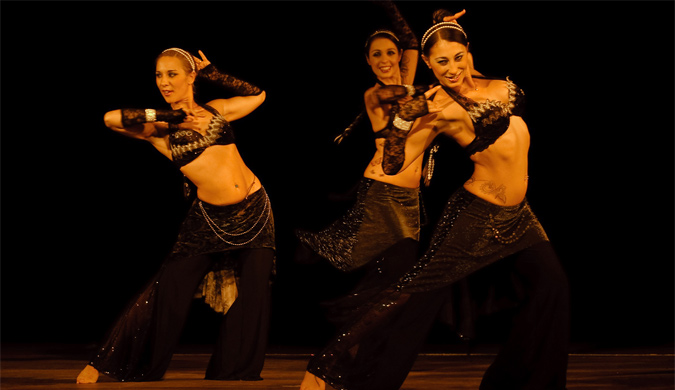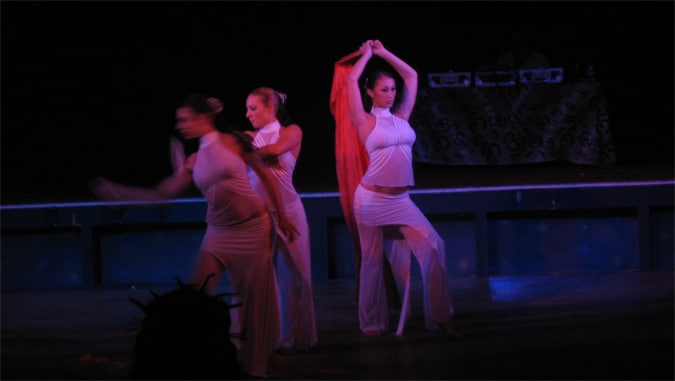How Practising Contemporary Dance can help Belly Dancers
Last Updated on January 28, 2024

Contemporary Dance and Belly Dance Intro
Belly dance and contemporary dance are two dance genres that are extremely different from each other and at first sight, they hardly have anything in common.
However, I find that practising contemporary dance can be useful for belly dancers to give more depth to their belly dance performance, whichever style they practise, be it Raqs sharqi or tribal.
I have only recently discovered contemporary dance and I have been practising it for over a year now.
Before starting to practise it I did not know much about this dance genre as it is not much talked about outside of specialist circles (which is a shame as it is a beautiful and very expressive dance form).
I am aware that there are various styles and techniques of contemporary dance, but my teacher focuses primarily on Dories Humphrey’s technique and a bit on Merce Cunningham style.
Doris Humphrey was an American dancer and choreographer at the beginning of the 20th-century author of the timeless book ‘The Art of Making Dances’.
Merce Cunningham was also a prominent American dancer and choreographer, active from the 1940s and was a great innovator.
Both are prominent figures in the history of western modern and contemporary theatre dance.
Concepts and techniques
From what I have gathered from practising contemporary dance, the sense of flow is very important and also the fact that, rather than going against gravity, the dancer embraces it and uses it to her/his own advantage to make the dance more expressive.
Also, breath is used to the dancer’s advantage to lead and support the movement.
These two concepts come from Doris Humphrey’s concept of ‘fall and recovery’, which teaches dancers how to use contraction and release of muscles and the cycle of breath.
Marta Graham’s technique also focuses on contraction and release of the muscles that allow energy to flow as they relax; however, her technique gives more angular results.
Marta Graham was another major figure in the history of western modern dance.
She was American and active from the first half of the 20th century until her death in 1991.
Her work was innovative, so at first, it was not very well received, but eventually, she was appreciated and her choreographies are considered great dance masterpieces.
Although belly dance has a completely different dance vocabulary from contemporary dance with smaller movements and a different philosophy and cultural background, I think that some of the concepts I have learnt through practising contemporary dance have helped my Raqs sharqi practice.

How These Concepts Apply to Belly Dance
The concepts of fall and recovery and breath, give belly dance movements a more fluid yet at the same time controlled quality.
Belly dance per se has a combination of fluid and percussive movements which alternate and combine according to the music.
By letting certain parts of the body relax (for example the upper back) it gives an impression of abandon and it makes the movement more lyrical.
However, as you catch the same movement towards the end of its trajectory by contracting the muscles it gives a feeling of control.
So, you can look fluid and relaxed while maintaining solid and well-defined movements.
Too much fluidity without catching the movement at the end makes it sloppy, while too much tension and no release make the movement too rigid and unnatural.
This is how, I think, experiencing contemporary dance and the way movement flows as part of ‘fall and recovery’ and ‘contraction and release’ techniques can give a belly dancer a better perception of control and release while she adapts these concepts to the belly dance movement vocabulary.
Also, these concepts in belly dance can be adapted to individual body parts.
For example, for a juicer variation of a hip maya (outward vertical figure of 8) one can think of holding the muscles involved (the oblique abdominals in this case), start releasing them gradually and then finish releasing them suddenly towards the end of the movement.
Belly Dancers Who Use Contemporary Dance Concepts
I first had the idea of practising contemporary dance when I went to a workshop in London held by Hungarian dancer Mercedes Nieto.
She went through some common movements used in Raqs sharqi (such as arabesque and big hip circle amongst many) and explained to us how to make them more intense.
In doing so she mentioned how the contemporary dance concepts of ‘fall and recovery’ and ‘contraction and release’ helped her achieve that effect.
In the video below you can maybe understand better what I mean by seeing how Mercedes’ style is wonderfully flowing but controlled at the same time.
Another example of dancers who draw from different styles and techniques, including contemporary dance, in their repertoire is the professional tribal group Les Soeurs Tribales, based in Milan, Italy.
Their style is an eclectic fusion of tribal belly dance with different styles.
You can see an example in the video below.
Where You Can Study Contemporary Dance?
In the UK you can learn any type of dance you wish in evening classes, mainly held in dance centres or community centres.
As for contemporary dance, evening classes are held generally in dance centres, most of which are charities or are subsidised by the government to promote the arts.
For example, in Cardiff, you can attend evening classes in the Rubicon Dance Centre, in The Gate and in Wonderland Studios.
If you want to study dance at university, there are also several dance degrees in the UK that specialise in contemporary dance, such as the course at Cardiff Metropolitan University.
As contemporary dance is a type of theatre dance, it is mainly performed on stage in theatres and it is usually affordable to go and see as these performances are generally sponsored by the government.
This is because this is not a mainstream dance genre and is still niche at the moment.
However, I strongly recommend going to see some performances as they are amazing.
For example, I recently saw a performance by the National Dance Company of Wales and they were outstanding.
Latest posts by Dr Valeria Lo Iacono (see all)
- Belly Dancing over the Age of 40, 50 and Beyond - February 1, 2025
- Health Benefits of Belly Dance - January 20, 2024
- 10 Countries for Learning Belly Dance - January 18, 2024
















